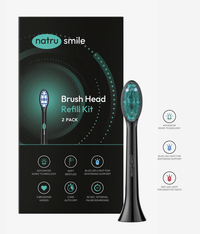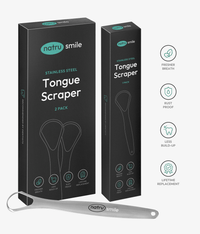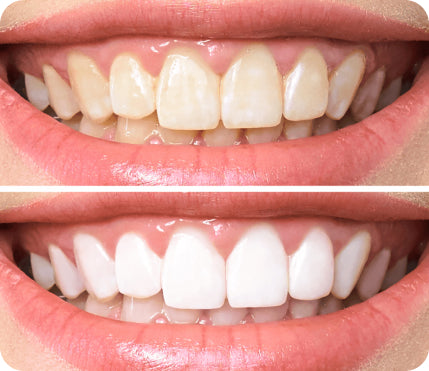
All products are certified by dental expert Dr. Greg Grillo
When it comes to dental restoration, you usually have two options - dental crowns and bridges. Both are used to replace missing teeth or strengthen weakened teeth, but they have different benefits and drawbacks. Knowing the differences between the two can help you decide which is best for your needs.
This article will discuss the differences between dental crowns and bridges, their uses, benefits, and drawbacks to help you make the choice that suits you.
Dental Crown Vs. Dental Bridge: A Quick Look
The main difference between a crown and a bridge is that a crown is placed on a single, damaged tooth while a bridge uses at least two teeth to support and hold it in place.
Crowns are usually used when there is only minimal damage or decay to the tooth, while bridges are often used when one or more teeth have been lost. This means that the choice is really based on what damage you have rather than your comfort or appearance.
Dental Crown Vs. Dental Bridge: Comparison
While the most important difference is their function, there are many other important factors to consider when deciding between a dental crown and a dental bridge. Both are common procedures used to restore damaged or missing teeth, but they each have distinct advantages and disadvantages.
Let's take a look at a few specific differences between dental crowns and dental bridges.
Functionality
As stated above, the functions of crowns and bridges are very different. A dental crown is used to protect and cap a damaged tooth, while a bridge fills the gap left by a missing tooth. Crowns are commonly used for teeth that have been severely weakened from tooth decay or injury, as they provide necessary support and strength.
Bridges, on the other hand, are usually fixed in place using adjacent natural teeth or implants. So the key difference is that crowns protect what is there, while bridges replace what was lost.
Cost
According to Dentaly.org, the cost of a dental bridge really depends on the type you’re getting, but it ranges from $500 to over $5,000. They mention that insurance, however, will sometimes cover up to 50% of the cost, so it’s important to talk to your provider.
Crowns are very similar in that cost depends on the type, but the average dental crown cost is usually around $1,000 for a permanent crown, while temporary crowns average about $450.
Material
Dental crowns and bridges are usually made from very different materials to suit their different functions. Crowns are usually made from either porcelain or gold, depending on your preference and budget.
Bridges can also be made out of either of these materials, but they most commonly use ceramic or zirconia, as they are strong and aesthetically pleasing. Using porcelain, zirconia, or ceramic gives the crown or bridge a natural appearance and feel. Gold is more flashy, but it is also more durable and resistant to wear and tear.
Time
Another considerable difference between crowns and bridges is the time it takes to implement them. A dental crown may take two visits to the dentist, while a bridge requires three or more. The first visit is usually for preparation and impressions, where the dentist will make models of your teeth. The second visit is when you get your permanent crown placed.
For a bridge, there are additional steps involved in preparing the surrounding teeth to support the bridge, so it typically takes longer than a dental crown procedure. If you are a busy person and don't need a tooth fully replaced, a crown may be the better option.
Quality
There are many kinds of crowns and bridges with different quality standards, but there is a general consensus on which procedure is better for quality. Dental crowns are typically made of porcelain, metal alloys, or both. Porcelain is preferred by most dentists because it appears more natural and provides long-lasting protection from decay.
Dental bridges, on the other hand, are often made from ceramic or zirconia, which are generally not as sturdy or durable as porcelain. This means your crowns will probably stay in place for an extensive period of time, but you may need your bridge replaced if you are prone to grinding your teeth or chew roughly.
Understanding Dental Crowns And Bridges
Which Is Better: A Crown Or A Bridge?
It all depends on what your needs and preferences are; there’s not one that’s generally better for everyone. Both are used to restore and improve a person's smile but have different purposes.
Crowns are used to restore a single tooth, while bridges are used to replace missing teeth. In general, crowns are better for addressing isolated dental issues like cracked or broken teeth, cavities, and discoloration. Crowns cover the entire visible part of your tooth above the gum line and help protect it from further damage. They also provide additional strength and stability to weakened teeth that can’t be restored with just a filling.
Bridges, on the other hand, are used to replace one or more missing teeth. They “bridge” the gap left by a missing tooth and are made of either porcelain fused to metal or all-porcelain material. Bridges are also great for improving aesthetics, as they improve the appearance of your smile and make it look natural.
How Do I Know If I Need A Dental Crown Or Bridge?
Dental crowns and bridges have very different functions that make it easy for you to decide which is right for you. Dental crowns are used to restore or improve the appearance and function of a tooth, while dental bridges provide an artificial replacement for one or more missing teeth. You would only need one or the other if you are having intrinsic issues with your teeth that have caused a loss or decay.
Can I Get A Crown Instead Of A Bridge?
Usually, you need either one or the other to address your needs. A crown doesn’t replace a lost tooth; it provides support to a damaged tooth. A bridge, on the other hand, is used when you are missing one or more teeth and need to fill in the gap.
Depending on your specific circumstances and dental needs, either one of these treatments could be right for you, but if you are trying to fill a gap left by a lost tooth, a crown cannot be used in place of a bridge.
What Is The Failure Rate Of Dental Bridges?
According to PubMed, a subsidiary of the National Library of Medicine, a study showed a failure rate of 35.5%. They failed due to a variety of factors, but the main reasons for failure were periodontal disease and secondary caries. Even so, the success rate of dental bridges is still quite high. In certain cases, a bridge may last more than 10 years and provide excellent results for the patient. The study showed the average lifespan of a bridge is 6.1 years.
What Is The Difference Between A Cantilever Bridge And A Maryland Bridge?
These two types of dental bridges are different in the way they are attached to other teeth. A dental cantilever bridge is only supported by one tooth, which is either a natural tooth or an implant placed for support. This type of bridge is usually used when there are only two teeth adjacent to each other that need restoration.
A Maryland bridge, on the other hand, uses two teeth located on both sides of the missing tooth space and has wings made out of porcelain or metal that attach to your teeth. Picking which one of these to use really depends on the number of teeth you want to be affected and the stability you want in your mouth.
What Is A Temporary Crown?
Temporary crowns are used in the dental office to protect a tooth from further damage while a permanent crown is being made. If you require a crown, your dentist will first take an impression of your teeth so that a custom-made crown is constructed for you. While this is happening, they may place a temporary one on the affected tooth to protect it during the waiting period.
Temporary crowns are usually made out of acrylic or stainless steel and should last anywhere between two weeks to several months, depending on how quickly the lab completes your final restoration.
Should I Get A Removable Bridge?
Removable dental bridges are a great option for those who want to restore their smiles without the cost and permanence of a dental crown or fixed bridge. A removable bridge consists of one or more false teeth attached to an acrylic plate, which is held in place by metal clasps that fit around your existing teeth.
This type of bridge is easy to remove when necessary and is taken out for cleaning and maintenance. So if you are scared of cost and/or cleaning, a removable dental bridge may be right for you.
What If I Feel Pain After Getting A Crown?
Dental crown pain is common after the procedure, but usually only lasts a few days. You may experience some soreness in your jaw or gums due to the pressure of the crown being put into place.
In most cases, over-the-counter pain medication will help reduce this discomfort. If you continue to feel pain after a few days, make sure to contact your dentist as soon as possible so they will check for any issues and provide appropriate treatment if necessary.
What’s The Verdict?
Unfortunately, there's no obvious verdict for dental crown vs dental bridge. It's up to you and your dentist to determine which option is best for you. Fortunately, both dental crowns and bridges are highly effective in restoring the function of your teeth or replacing missing teeth.
If you're considering either of these treatments, try to understand whether you need minor touch-ups with a crown or a full replacement with a bridge, then talk to your dentist about what's right for you.












